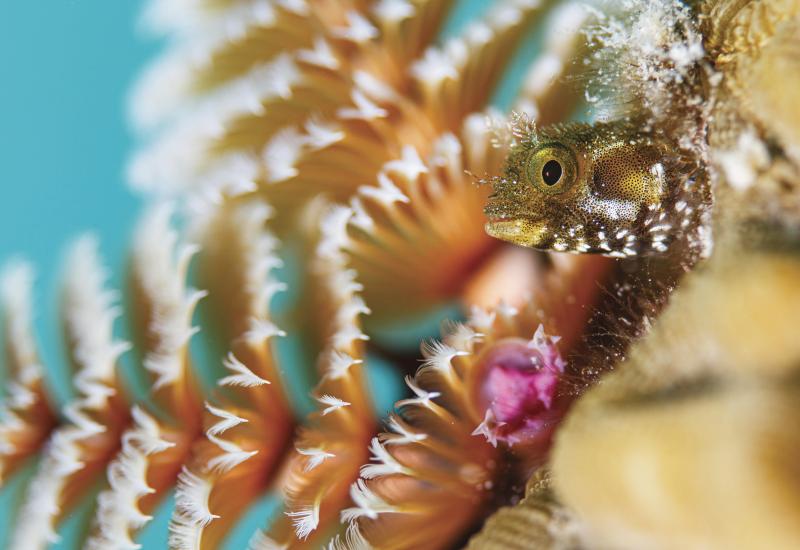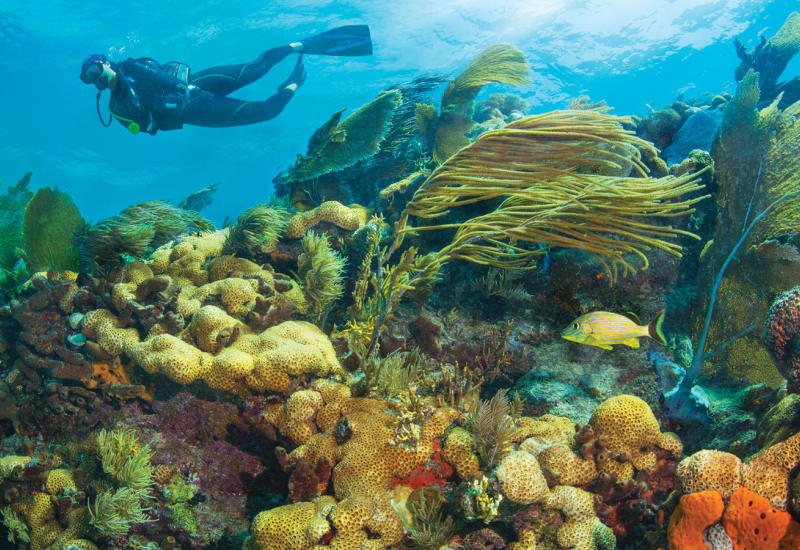Venice Beach, Fla.
By Kyle Lent As I’m scouring a vast, underwater graveyard littered with remnants of ancient predators, I’m scanning the ocean floor, looking to unearth a window into the past. Minutes into the dive, the sandy ocean bottom, engulfed with whelks, sand dollars and sea urchins transforms into a much darker, denser, and less inviting ground. That makes me smile, because I know I’ve hit what’s called “black sand”—the combination of millions of ground fragments of fossils such as turtle shells, stingray barbs and dugong bones, giving the appearance of a dark, silty surface. I know the big prize is nearby. Then, suddenly it takes shape and appears before my eyes—a four-inch shark’s tooth, resting gently atop the sea bed, with serrated edges outlining its smooth, jet black surface. But it’s not just any shark tooth. It belongs to the carcharocles megalodon, a prehistoric giant shark, the largest carnivorous fish ever to have existed. Millions of years ago, megalodons freely roamed off the coast of present-day southwest Florida, before their feeding grounds were gradually transformed by the shifting of continental plates into landmasses such as swamps and vast plains, and in some places, reclaimed by the ocean. Today, hundreds of eager divers from beginners to experts flock to Venice Fla., 60 miles south of Tampa, in search of their very own “meg” tooth. Venice, with a population of just over 20,000, even hosts an annual weekend Sharks Tooth Festival in April where divers converge on the “Sharks Tooth Capital of the World,” where millions of years ago, various species of sharks, including the megalodon ruled this area of the Gulf of Mexico. Long after their extinction, they’ve left behind an abundance of teeth scattered across eight to 10 different dive sites for divers to forage, from either beach or boat.
Venice Pier
The area just north of this dock has some of the best examples of meg teeth ever found in the region. Divers gear up in a public parking lot off of Harbor Drive near a restaurant fittingly called Sharky’s, then walk from their cars to the water. The most promising shore dives are in 20 to 25 foot depths, where you’ll likely find countless teeth in the half-inch to one-inch range. If you’re lucky, you’ll find teeth much larger and thicker — up to a maximum of six inches. Due to its gradual sloping bottom, to get to the 25-foot depth range off the pier, you’ll need to go about 150 yards out to sea. So before making your descent, backpaddle along the surface to maximize your bottom time until you’re even with the end of the Pier. When you hit the black sand, it’s time to start hunting.
Casperson Beach
This shark tooth hot spot and beach dive, on Venice Island’s southern tip, south of the town pier, has also been known to contain great numbers of teeth. There are a series of ledges here, in a maximum depth of 25 feet, which provide a great tooth hunting environment. New deposits of fossilized teeth are exposed on freshly unearthed bedrock daily thanks to currents. An ancient riverbed running a quarter mile offshore, parallel to the coast, called the Bone Pit is also a great area to search, and is accessible only by boat. Companies like Florida West Scuba School and Nitrogen Narcosis run two-tank charters almost daily to that area, where there’s an accumulation of countless years of fossilized remains. Boat captains take note of the hot spots divers find, record the coordinates and use GPS technology to return later to those sites. That doesn’t guarantee you’ll find big meg teeth, but it’ll give you an idea of where divers have had the most success. I found two of my best meg teeth in the Bone Pit. The Venice area represents one of those rare diving opportunities where divers are actually rewarded with tangible souvenirs—pieces of the planet’s history—unlike most other dive destinations, where only pictures and memories can be taken. One evening, as I’m sitting on Venice Beach watching the sun set, I see a young boy clutching what quite possibly is the first meg tooth he has ever found. It’s tiny, but to his excited eyes, it’s the worlds biggest. The scene makes me realize why this place is so magical to divers, who come from many miles away to experience the thrill. Photographs last a lifetime, but the prehistoric sharks teeth in these waters have lasted millions of years—and will still be here long after we’ve gone. Getting There: From Tampa, take Interstate 75 South to Exit 200 toward Venice, on FL 681 South. Continue until taking a slight right on Tamiami Trail, then right on Avenida del Circo. Turn right when road dead ends onto Airport Avenue, then go left on Harbor Drive. A public parking lot and the beach is at the end of Harbor Drive. Dive Conditions: In summer, surface water temps are generally between 75 and 80 °F and visibility between 10 to 20 feet. In winter, expect water temperatures in the mid-50s with 10-foot maximum visibility. A wetsuit isn’t required for summer diving, but be prepared with at least a 5mm suit in winter. The best diving is usually between May and September
By Kyle Lent As I’m scouring a vast, underwater graveyard littered with remnants of ancient predators, I’m scanning the ocean floor, looking to unearth a window into the past. Minutes into the dive, the sandy ocean bottom, engulfed with whelks, sand dollars and sea urchins transforms into a much darker, denser, and less inviting ground. That makes me smile, because I know I’ve hit what’s called “black sand”—the combination of millions of ground fragments of fossils such as turtle shells, stingray barbs and dugong bones, giving the appearance of a dark, silty surface. I know the big prize is nearby. Then, suddenly it takes shape and appears before my eyes—a four-inch shark’s tooth, resting gently atop the sea bed, with serrated edges outlining its smooth, jet black surface. But it’s not just any shark tooth. It belongs to the carcharocles megalodon, a prehistoric giant shark, the largest carnivorous fish ever to have existed. Millions of years ago, megalodons freely roamed off the coast of present-day southwest Florida, before their feeding grounds were gradually transformed by the shifting of continental plates into landmasses such as swamps and vast plains, and in some places, reclaimed by the ocean. Today, hundreds of eager divers from beginners to experts flock to Venice Fla., 60 miles south of Tampa, in search of their very own “meg” tooth. Venice, with a population of just over 20,000, even hosts an annual weekend Sharks Tooth Festival in April where divers converge on the “Sharks Tooth Capital of the World,” where millions of years ago, various species of sharks, including the megalodon ruled this area of the Gulf of Mexico. Long after their extinction, they’ve left behind an abundance of teeth scattered across eight to 10 different dive sites for divers to forage, from either beach or boat.
Venice Pier
The area just north of this dock has some of the best examples of meg teeth ever found in the region. Divers gear up in a public parking lot off of Harbor Drive near a restaurant fittingly called Sharky’s, then walk from their cars to the water. The most promising shore dives are in 20 to 25 foot depths, where you’ll likely find countless teeth in the half-inch to one-inch range. If you’re lucky, you’ll find teeth much larger and thicker — up to a maximum of six inches. Due to its gradual sloping bottom, to get to the 25-foot depth range off the pier, you’ll need to go about 150 yards out to sea. So before making your descent, backpaddle along the surface to maximize your bottom time until you’re even with the end of the Pier. When you hit the black sand, it’s time to start hunting.
Casperson Beach
This shark tooth hot spot and beach dive, on Venice Island’s southern tip, south of the town pier, has also been known to contain great numbers of teeth. There are a series of ledges here, in a maximum depth of 25 feet, which provide a great tooth hunting environment. New deposits of fossilized teeth are exposed on freshly unearthed bedrock daily thanks to currents. An ancient riverbed running a quarter mile offshore, parallel to the coast, called the Bone Pit is also a great area to search, and is accessible only by boat. Companies like Florida West Scuba School and Nitrogen Narcosis run two-tank charters almost daily to that area, where there’s an accumulation of countless years of fossilized remains. Boat captains take note of the hot spots divers find, record the coordinates and use GPS technology to return later to those sites. That doesn’t guarantee you’ll find big meg teeth, but it’ll give you an idea of where divers have had the most success. I found two of my best meg teeth in the Bone Pit. The Venice area represents one of those rare diving opportunities where divers are actually rewarded with tangible souvenirs—pieces of the planet’s history—unlike most other dive destinations, where only pictures and memories can be taken. One evening, as I’m sitting on Venice Beach watching the sun set, I see a young boy clutching what quite possibly is the first meg tooth he has ever found. It’s tiny, but to his excited eyes, it’s the worlds biggest. The scene makes me realize why this place is so magical to divers, who come from many miles away to experience the thrill. Photographs last a lifetime, but the prehistoric sharks teeth in these waters have lasted millions of years—and will still be here long after we’ve gone. Getting There: From Tampa, take Interstate 75 South to Exit 200 toward Venice, on FL 681 South. Continue until taking a slight right on Tamiami Trail, then right on Avenida del Circo. Turn right when road dead ends onto Airport Avenue, then go left on Harbor Drive. A public parking lot and the beach is at the end of Harbor Drive. Dive Conditions: In summer, surface water temps are generally between 75 and 80 °F and visibility between 10 to 20 feet. In winter, expect water temperatures in the mid-50s with 10-foot maximum visibility. A wetsuit isn’t required for summer diving, but be prepared with at least a 5mm suit in winter. The best diving is usually between May and September










